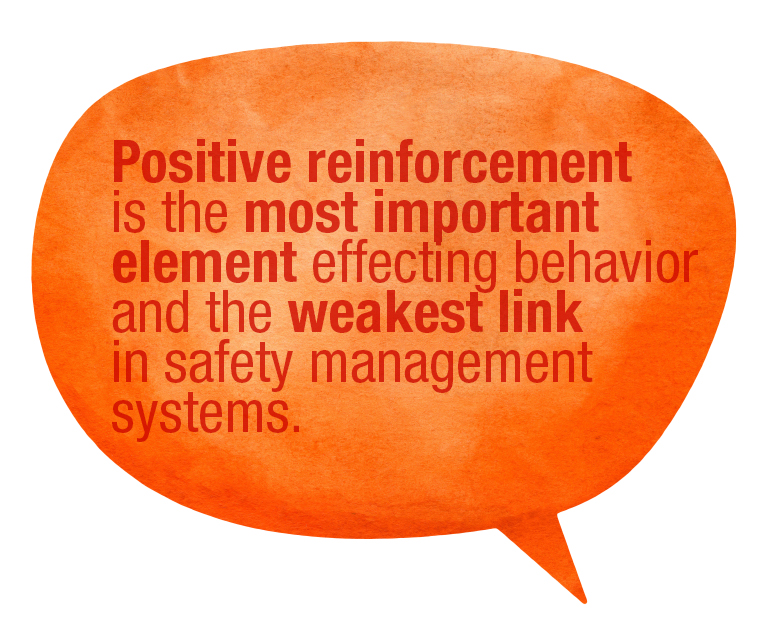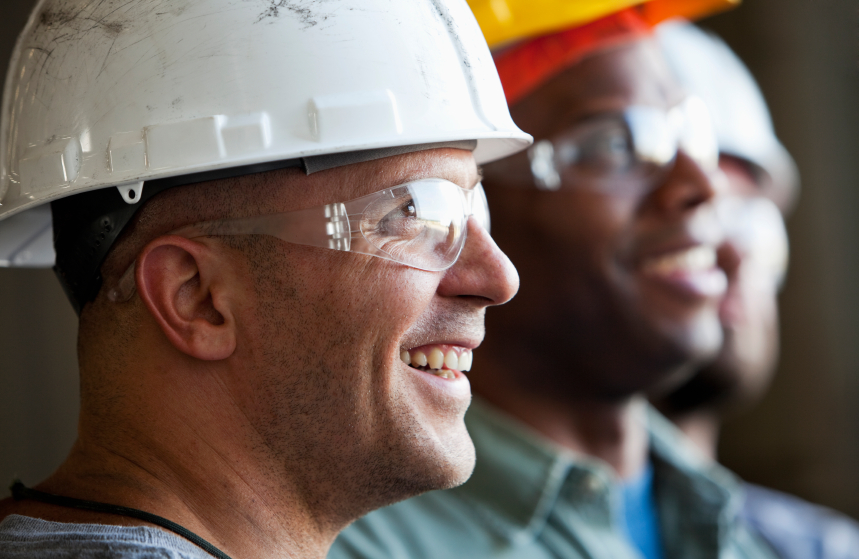For The Record: Incentives and Safety
Many safety experts warn of the danger of "dangling a carrot" in front of people as a means of getting them to act safely. The claim is that safe working behavior generated by incentives or gimmicks, such as mugs, t-shirts, and other shiny objects, is inferior to behavior generated by other means. Words and phrases like "gimmick" and "dangling a carrot" are emotionally charged and tend to convey a superficial approach and, even worse, a sinister motive behind such attempts to get people to work safely. With all due respect to the experience of those who express such beliefs, the issue of whether incentives and gimmicks have a place in developing an effective safety culture is not a matter of anyone’s belief—it is an empirical matter. Either incentives work or they don’t. So-called "gimmicks" such as mugs, belt buckles, caps and t-shirts either work or they don’t. There is 80 years of research on the conditions under which they work and do not work. When this body of research is ignored, it should not surprise anyone that many of the ways in which incentives are applied, do not work.
The Conditions
 In order to understand when incentives are and are not effective, some basic elements of behavior change need to be understood. The first is positive reinforcement. Positive reinforcement is the most important element affecting behavior and the weakest link in most safety management systems. If you look at the bulk of seminar presentations and magazine articles describing the management of safety-related behavior, you find that positive reinforcement, feedback, recognition and reward (see inset) are all used interchangeably as though they refer to the same process. They don’t. In addition, a common perception in the safety area is that public praise, a pat-on-the back, telling someone that they are doing a good job, and "positive feedback" are positive reinforcers. They are not. With this poor level of understanding of the most important concept for managing human performance in safety, it is no wonder that there are problems and confusion about what to do and not to do.
In order to understand when incentives are and are not effective, some basic elements of behavior change need to be understood. The first is positive reinforcement. Positive reinforcement is the most important element affecting behavior and the weakest link in most safety management systems. If you look at the bulk of seminar presentations and magazine articles describing the management of safety-related behavior, you find that positive reinforcement, feedback, recognition and reward (see inset) are all used interchangeably as though they refer to the same process. They don’t. In addition, a common perception in the safety area is that public praise, a pat-on-the back, telling someone that they are doing a good job, and "positive feedback" are positive reinforcers. They are not. With this poor level of understanding of the most important concept for managing human performance in safety, it is no wonder that there are problems and confusion about what to do and not to do.
 What then is positive reinforcement? There are several important characteristics. The first is that positive reinforcement is defined as any consequence that follows a behavior and increases the frequency of that behavior in the future. While praise, a pat-on-the-back, etc. may be positive reinforcers, they also may not be for a given person in a particular situation. It is not unusual that people who have been praised in public, do things to avoid such recognition in the future because the event was embarrassing to them. One of the most common errors that people make in attempting to positively reinforce safe working behavior is to choose things that you say, do or give to everybody. While saying, "Thank you for picking that package up with your legs rather than your back," may be reinforcing to someone one time, it will rarely be reinforcing to anyone if said frequently. Also, it is not a reinforcer to everybody when said only one time. Even the most commonly used attempt to positively reinforce, the "pat-on-the-back," is not reinforcing to everybody. Everyone has a different set of reinforcers. It is one of the things that makes us different. The things that people will spend their discretionary time and money to do are endless and no two people are reinforced by exactly the same things. Therefore, you can see the error of buying coffee mugs for everybody who meets some safety goal. While there are some things that practically everyone likes, you can find individuals who will not be reinforced by them. In order to develop the most effective relationship with another person, you must first know that person’s reinforcers. The bottom line is that no matter what you use, if the person’s behavior does not increase, it was not a positive reinforcer to that person.
What then is positive reinforcement? There are several important characteristics. The first is that positive reinforcement is defined as any consequence that follows a behavior and increases the frequency of that behavior in the future. While praise, a pat-on-the-back, etc. may be positive reinforcers, they also may not be for a given person in a particular situation. It is not unusual that people who have been praised in public, do things to avoid such recognition in the future because the event was embarrassing to them. One of the most common errors that people make in attempting to positively reinforce safe working behavior is to choose things that you say, do or give to everybody. While saying, "Thank you for picking that package up with your legs rather than your back," may be reinforcing to someone one time, it will rarely be reinforcing to anyone if said frequently. Also, it is not a reinforcer to everybody when said only one time. Even the most commonly used attempt to positively reinforce, the "pat-on-the-back," is not reinforcing to everybody. Everyone has a different set of reinforcers. It is one of the things that makes us different. The things that people will spend their discretionary time and money to do are endless and no two people are reinforced by exactly the same things. Therefore, you can see the error of buying coffee mugs for everybody who meets some safety goal. While there are some things that practically everyone likes, you can find individuals who will not be reinforced by them. In order to develop the most effective relationship with another person, you must first know that person’s reinforcers. The bottom line is that no matter what you use, if the person’s behavior does not increase, it was not a positive reinforcer to that person.
 The second characteristic is that positive reinforcement is immediate. That means that when positive reinforcement is delivered while a person is working safely, the behaviors occurring at that time are the ones that are reinforced. It is obvious that reinforcing safe-working behavior when it is occurring is the most efficient and effective way to reinforce. This has many implications for a safety culture. It means first and foremost that, managing safety behavior is about what happens day to day. Anything that leaders and peers can do to build in more immediate reinforcement will have a much greater impact than anything that happens at the end of the month, quarter, or year.
The second characteristic is that positive reinforcement is immediate. That means that when positive reinforcement is delivered while a person is working safely, the behaviors occurring at that time are the ones that are reinforced. It is obvious that reinforcing safe-working behavior when it is occurring is the most efficient and effective way to reinforce. This has many implications for a safety culture. It means first and foremost that, managing safety behavior is about what happens day to day. Anything that leaders and peers can do to build in more immediate reinforcement will have a much greater impact than anything that happens at the end of the month, quarter, or year.
The third is that one positive reinforcement does not make a habit. Safety is mostly about habits. Depending on the complexity of a particular safety habit, it may require hundreds of occasions of positive reinforcement to attain habit status. This has obvious implications for whether a reward, which usually occurs very infrequently, can significantly effect a safety habit.
Ineffective Incentives
When you understand the previously stated facts about reinforcement, it is relatively easy to see the conditions under which incentives work and do not work. Incentives can be reinforcers, but several things tend to reduce their effectiveness :
They are practically always delayed. They are rarely given when safe-working behaviors are occurring. The behavior they are intended to strengthen may have occurred months before and may be no longer occurring. In some cases because of the delay, the behavior occurring at the time of the delivery of the incentive may not be something that you would want to encourage.
The link between the behaviors and the incentive is usually weak. Most safety incentives are dispensed to everyone who participated in the effort, regardless of their rate of safe behavior. Some people work actively to do everything safely while others do not, and everyone gets the incentive if some common goal was reached. It is common that people who are habitually unsafe get the incentive simply because they were on the team and not because of their behavior. This, of course, makes the incentive less valuable to those who worked hard to get it.
Not all incentives are desirable (reinforcers) to the performers. Just because you put a company logo on a cap, jacket or key chain does not necessarily make them valuable.
Making Incentives Effective
Here are some tips on how to make incentives effective:
- Positive reinforcement has to be a daily affair. In spite of a lot of talk about positive reinforcement, most safety systems are still driven by negative reinforcement. I have written elsewhere (Daniels1) about how to determine if performance is being driven by positive or negative reinforcement. It is more difficult to determine than it first appears. If positive reinforcement is not a common occurrence on a day-to-day basis, no incentive will be effective. You cannot expect people to be excited about some incentive when they have been working under negative reinforcement day to day. As Tom Odom of Shell Oil says, "It is hard to celebrate when you’ve been beat-up on the way to party."
- The delay between the behavior and the incentive must be bridged. Since reinforcement is immediate, some event that has reinforcing value must occur in proximity to the safe behavior. Points that are related to an incentive are one way to bridge the gap. The points must be paired frequently with social reinforcement to maximize their motivational value.
- The incentive must be earned. There must be only one way to get the incentive and that is through safe behavior on the job every day. If there are other ways to get it (e.g., underreporting or just being lucky), don’t blame the performers if they don’t do what was intended. Change the incentive system.
- The incentive must have personal value. The dollar value of the incentive is unimportant as long as the item is meaningful to the performers. If the incentive creates a positive memory of some safety accomplishment, the amount of money spent on it is unimportant. The tee shirt, coffee mug, or key chain will be valuable only if it stands for an accomplishment of which the performer is personally proud. By the way, telling people they should be proud does not necessarily make them proud.
 The presentation of the incentive should be preceded by a celebration. A celebration in this context is an opportunity for the performers to re-live the accomplishment. The participants, not the bosses, should be able to recount the things they did to meet the goal. Done this way, the incentive anchors a memory of an accomplishment and as such is more valuable.
The presentation of the incentive should be preceded by a celebration. A celebration in this context is an opportunity for the performers to re-live the accomplishment. The participants, not the bosses, should be able to recount the things they did to meet the goal. Done this way, the incentive anchors a memory of an accomplishment and as such is more valuable.
- Money is not the best incentive. While money can be used occasionally it should not be the main incentive. Even though money is liked by most people, in most circumstances, it provides limited reinforcement for the cost. Money is soon spent and the memory of it soon fades, where other tangible incentives are kept longer as a constant reminder of some safety accomplishment. If celebrated appropriately, the behaviors involved in it will be remembered as well.
When these things are done, incentives can have motivational value for safe behavior. When any of these things are omitted, or done poorly, you can expect negative reactions and poor safety results. As a part of a system of reinforcement, incentives can add energy and excitement to a safety culture. When used without regard to reinforcement, they add little and can actually be counterproductive.


